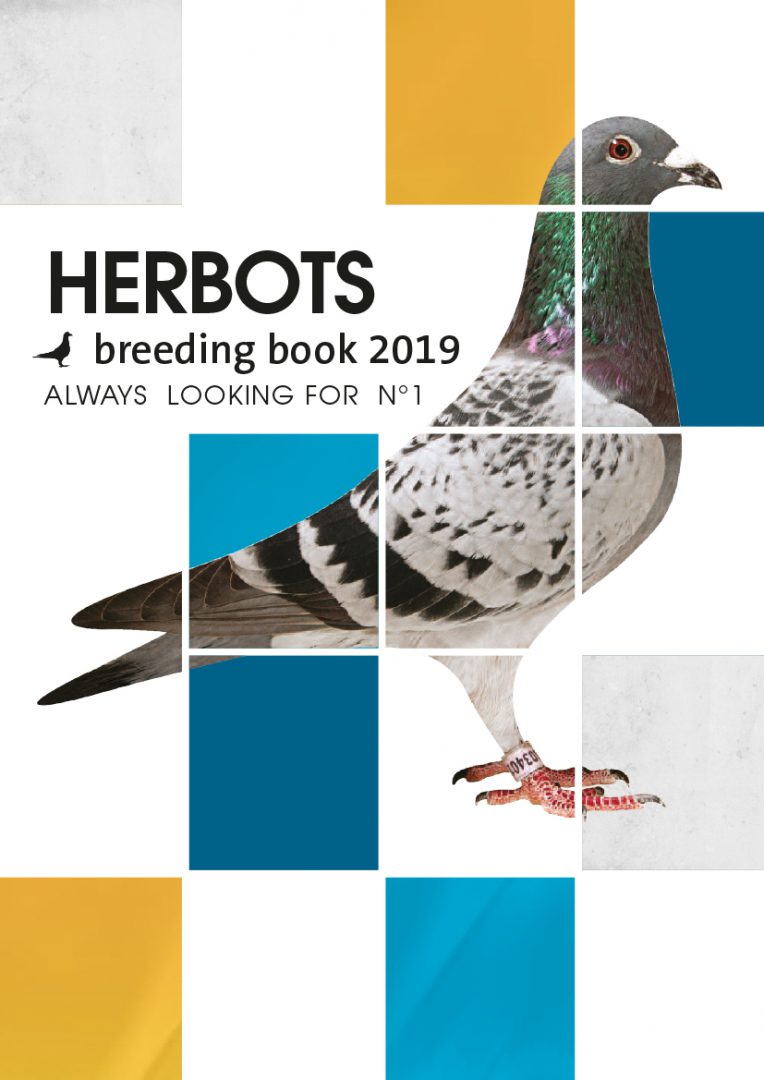Gebr. Herbots – 1. Olympic Pigeon Allround (Cat. D)
Halle-Booienhoven – Halle-Booienhoven is a city in the shadow of Sint-Truiden. Next to apples and pears they also had in the region a pack of known pigeon fanciers like for example Gebr. Clerinx, Nieuwerkerken; Jef Kempeneers, Nieuwerkerken; Emiel Matterne, Overhespen and pharmacist Daenen, Landen. They wrote together the successful pigeon history in the fruit region. New names came along and one of the high lights of the past decades is without a doubt Jo and Raf Herbots who race with the name Gebr. Herbots. The icing on the cake after a successful season in 2018 was the 1st Olympiad bird All Round (Cat. D) Poland 2019!
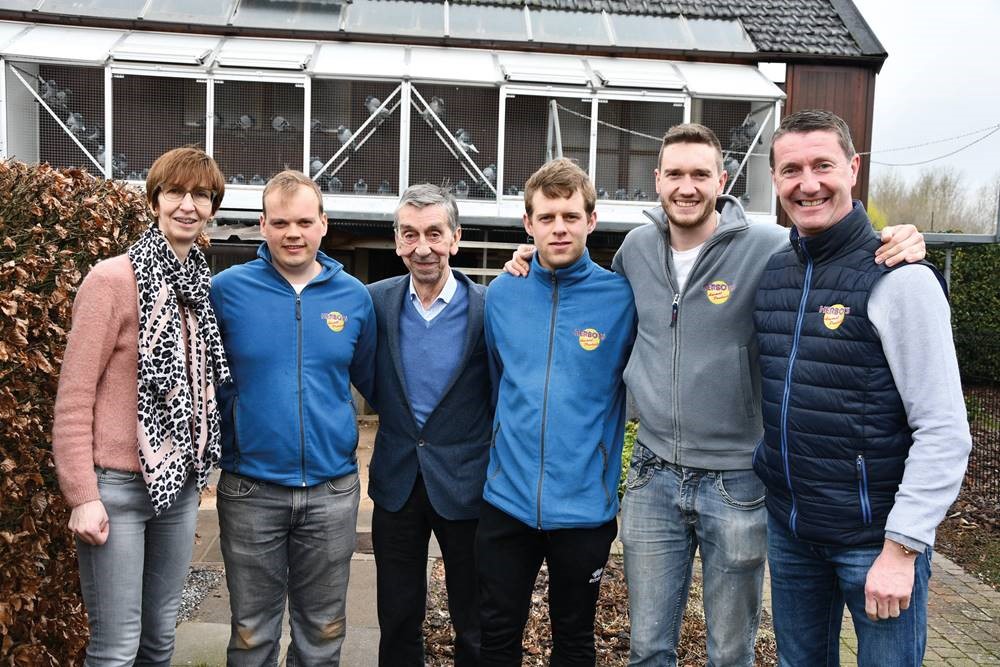
Father Leon Herbots
Father Leon Herbots was pigeon fancier and mother Elise was 110% pigeon fancier. The 3 brothers were all pigeon fanciers. Also grandfather on mothers’ site, Jozef Boyen, was a fancier through and through. He promised his wife one day that he would win her a new dress with the pigeons. When they were waiting for the pigeons that Sunday, Jozef saw his champion coming home and he shouted ‘Tilleke, there is your new coat arriving !’ A very beautiful nostalgic moment that Filip will never forget.
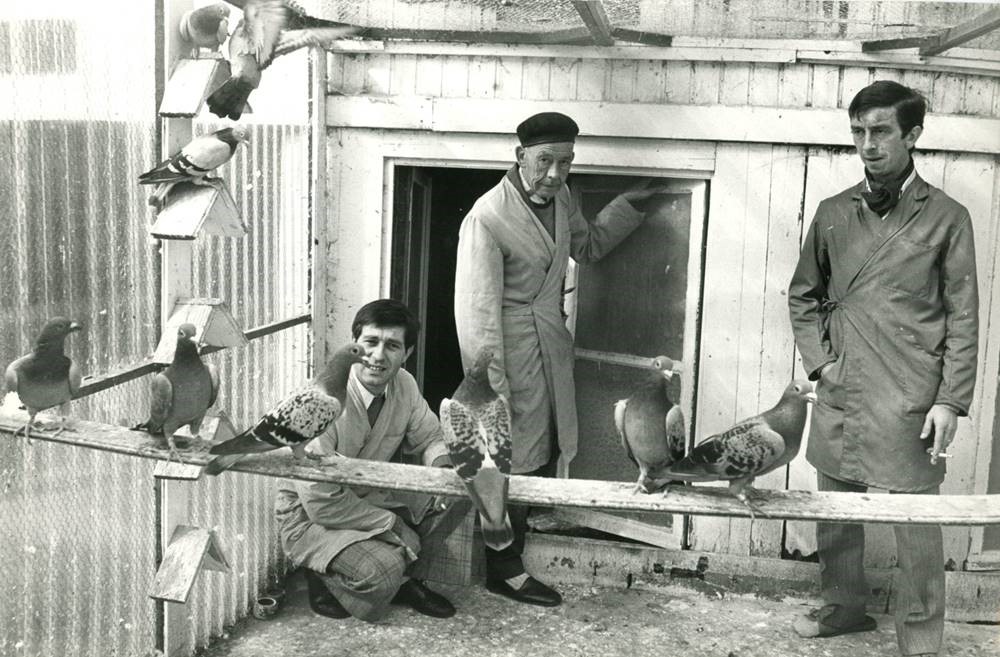
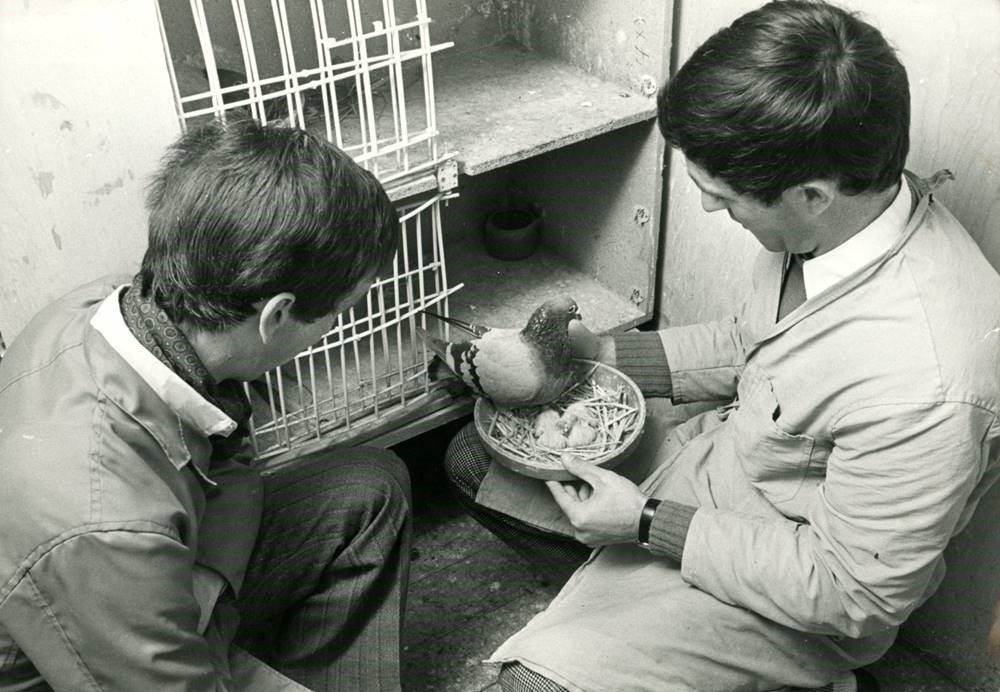
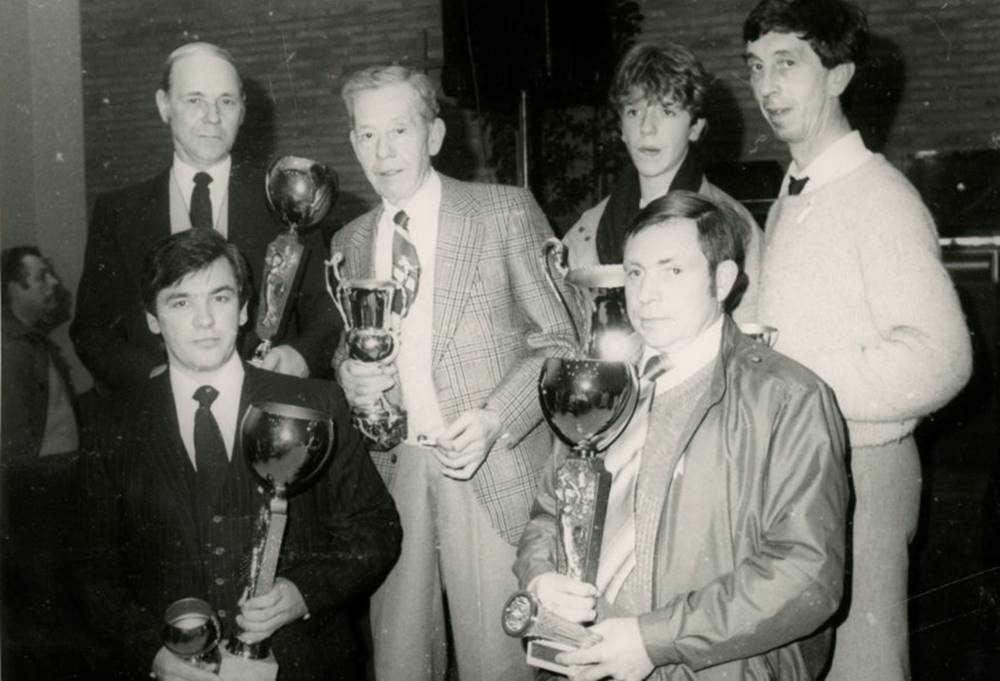
Filip (10) and his brother Jos (12) had good results in school and in 1953 they could start on their own with pigeons. They got their first couple of pigeons through eggs from butcher, René Beckers, Sint-Truiden. The brothers Herbots went to collect them with their motorcycle. Also pigeons from their mothers’ brother arrived and this is how they started to race from their small loft above the ‘cutting house’ from father who was also a butcher. Filip and Jos raced together until Jos got married. Father Leon used to race together with his brother but from the moment Filip and Jos started with pigeons he raced together with them. Jos built a house and pigeon lofts in Nieuwerkerken and father Leon went to go and live with him in 1977. Filip continued on his own and continued with the name Gebr. Herbots and Jos raced with the name Jos and Filip Herbots in Nieuwerkerken. When Jo and Raf where 12 and 13 years old they raced independent with the name Gebr. Herbots. Filip set one condition and that was that they would never send in their results for the youth championship !

Base of the colony
In 1970 the first pigeons from Kamiel Dendoven, Zuienkerke came onto the loft. In 1973 pigeons from Gebr. Clerinx, Nieuwerkerken came to reinforce the loft. Miel Clerinx and Jos Herbots where good friends. In 1973 they got pigeons from Frans
Stoces, Winterslag and in 1975 they already had 110 direct Stocesduiven on their loft.
In 1980 they went to Pros Roosen, Kermt. But more big names came to the loft like for example Jan Gondelaers, Opglabbeek (1980); Jos Soontjens, Wommelgem (1988) and Karel Schellens, Kessel (1991). The most famous Schellens-pigeon was “Nationaal I” who won the 1st national Bourges, 1st Provincial Orleans and 3x 1st prizes on other races.
In 1991, Jos Soontjens stopped racing pigeons and the entire loft was sold to Taiwan trough Herbots after they passed by the lofts in Halle-Booienhoven. These Soontjes pigeons made some top fanciers via Herbots like for example Denis Sapin. The best buy ever was the total loft of Karel Schellens in 1991.
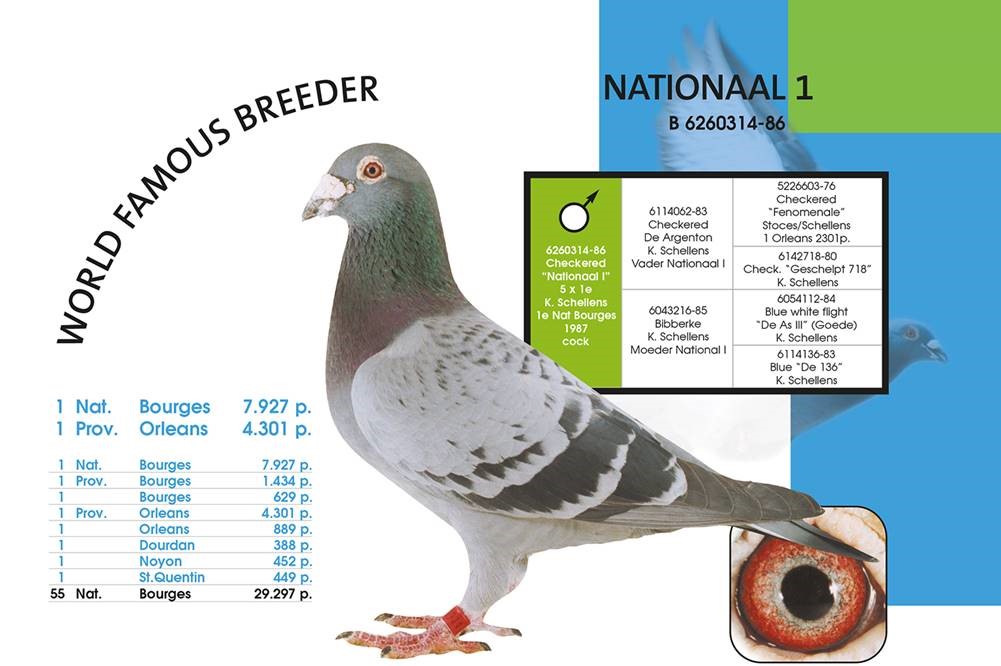
More pigeons came from Van Avondt & Zoon, Haacht (1999) with a.o. “Queen 2000” (1st Nat. Ace bird GMD at Gebr. Herbots). Later on two more ace pigeons from Van Avondt were bought. “Million” (1st Nat. ace bird GMD KBDB) and “Super Million” (2nd Nat. Ace bird GMD KBDB) came to strengthen the loft. Gebr. Herbots and Jos Deno formed the tandem Deno-Herbots. With the tandem Deno-Herbots some pigeons were swopped to race. One of them is “Yvan” who became in 2008 at Herbots the 4th National Ace bird GMD KBDB and in 2009 the 1st National Ace bird SMD KBDB.
Recently they got reinforcement and an excellent cooperation came with Johny Jonckers, Oplinter; Bart Van Oeckel, Oud-Turnhout and Antony Maes, Waregem.
Total widowhood
The Gebr. Herbots started of the season in 2018 with 30 old hens and 25 old cocks who raced total widowhood, also 60 yearling hens and 45 yearling cocks. The bigger part of the year bird team were also raced on total widowhood but 24 hens were raced on widowhood with 12 home staying cocks.
Next to these 200 youngsters (at the start) they had 25 breeders in the boxes and 25 couples breeders (children out of pigeons in the boxes where the bigger part raced themselves) formed the support.
The 55 old pigeons and 105 yearling pigeons were being prepared the same way for the coming season. The first coupling took place on the 6th of December and also the breeders were being coupled then. They all could raise a couple of youngsters. The racing team didn’t have a second coupling anymore.
At good weather they start training at the end of March and in 4 stages it went to 35 km. When they get home from the training flights the cocks and hens could come together in the hallway. After that it was 2x 100km, 2x 200km and next the races from the greater middle distance. Every week they went into the basket and about 12 old pigeons also went to the long distance races.
As from half of April the hens and cocks train twice a day for a full hour. Cocks and hens come together at the day of basketing for about 1 to 2 hours. After arrival from a race the partners can stay together for one hour but as the season continued on it could be until the day after.
Once trained, the old and yearling team will be released on Wednesday at 25km and the cocks and hens then usually come together. The boxes are being closed during the week and shelfs are being placed to sit on. The boxes only open at basketing and at the arrival from a race.
Very important is the eye of the fancier that has to evaluate the behaviour of all cocks and hens on Wednesday or after arrival from a race. The “Olympic Boss”, Olympiad bird 2017, thanks his result to the eye of loft manager Geoffrey. He noticed that this cock had 2 hens. He had one in his own box and had also a sweetheart under a box in the hallway in front of the loft. This way he had his ‘hands full’ in defending his territory and this resulted in his Olympiad title.
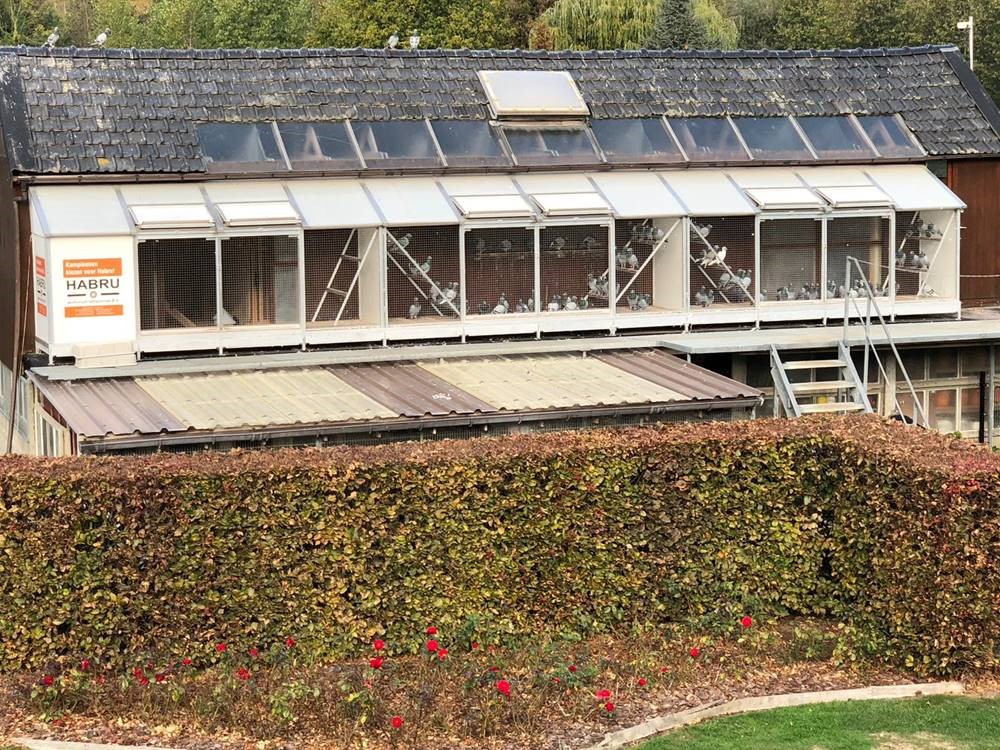
1. Olympiad pigeon “Olympic Chantal”
“Olympic Chantal” B16/3122016 is 1st Olympiad bird All Round Poland 2019. She came onto the lofts in Halle-Booienhoven by exchanging pigeons with Antony Maes, Waregem. She was bred by Antony Maes and raced by Gebr. Herbots. She collected a marvellous palmaris with a 1st Interprovincial Nevers 774b, 1st Sourdun 740b, 1st Vierzon 595b, 2nd Interprov. Bourges 3,799b, 2nd Momignies 468b, 2nd Sourdun 449b, 2nd Sourdun 275b, 3rd Interprov. Bourges 2n620b, 4th Interprov. Bourges 2,083b, 6th Interprov. Chateauroux 1,460b, 11th Bourges 915b.
“Olympic Chantal” is a rather small hen with a lot of feathers. It is a very attentive pigeon with a very smart head. It is a calm hen that has really well closed vent bones and has a lot of muscles. She has on both sides ‘2 working pins’ in her wings and has a perfect eye.
Next to “Chantal” the Gebr. Herbots have with “Golden Sixteen” B16/6056655 also a 4th Olympiad bird Middle Distance. This pigeon is a direct Bart & Nance Van Oeckel, Oud-Turnhout. By exchanging pigeons with Bart & Nance Van Oeckel they have together with this last one B16/2146231 “Daughter Kenzo” and B16/2146310 “Sister 1st nat. Limoges” (inbred Nationaal I), the 5th and 6th Olympiad bird long distance.
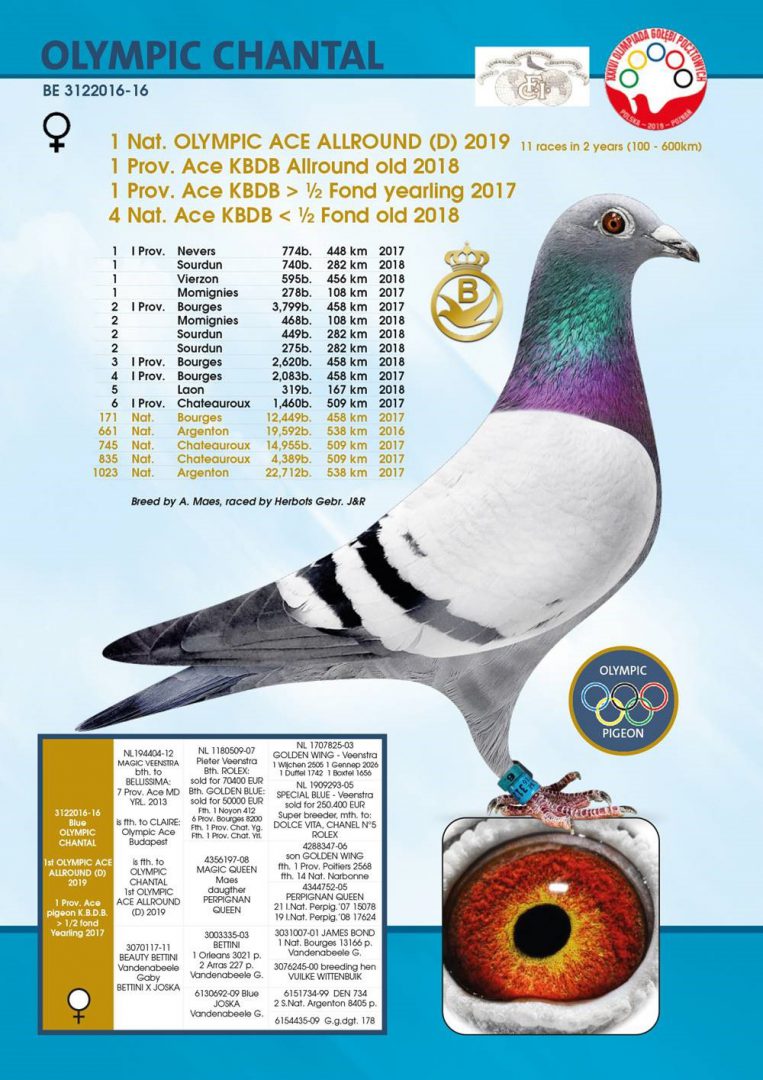
Youngsters with sliding doors
The 200 youngsters are bred from the breeders and the most important racers. From the top breeders the eggs will be taken away and placed with the racing pigeons. The youngsters are being weened at the age of around 25 days and when the feathers under the wings are fully grown together. The youngsters are being darkened from the 1st of April until the 21st of June. At 16h00 the blinds automatically close. At 23h30 they open again and the youngster wake up with daylight. As from the 21st of June until the end of the season they will be enlightened from 5h30 until 22h45. The training is taking very seriously. In about 20 stages they go from 3km to 45km. Then they go with the club to train. Once trained they are being tossed 2 to 3 times a week at 45km.
The sliding door is being introduced before the start of the national races. Also carton boxes are being placed on the lofts where the youngsters can play around as much as they like. The young pigeons get together the day before basketing but it can be also at the day of basketing itself. Everything depends on their shape and the eye of the loft manager. The youngsters train after the widow cocks and they have to train for one hour obliged. Training is off course very important, it is the criterion of the shape. At the beginning they train with the flag.
Filip Herbots : “Very important on all this is the care taker of the pigeons. Geoffrey knows by hart all the pigeons by ring number and their pedigree when they are in the air. That is the difference between a normal and a super loft manager! ‘
Beyers mixtures
Nearly all pigeons are being basketed weekly and they all follow the same feeding schedule. The Gebr. Herbots put their confidence in the Beyers mixtures. Saturday at arrival of a race they get Energy Galaxy (fat rich mixture) and electrolytes are provided in the drinking water. On Sundays it’ll be 50% Energy Galaxy + 50 % Energy Galaxy Light. In the drinking pots there is Herbo Aqua Control. As feeding supplements they get 4 Oils + Proteins Pro Recup HAP alternated with Tarsin (Herbovet) over the food.
On Monday it is 100 % Energy Galaxy Light with Herbo Aqua Control in the drinking pot and the same feeding supplements from Sunday go over the food. On Tuesdays it stays 100 % Energy Galaxy Light with Herbosol in the drinking pot and Zell Oxygen and Optimix over the food.
On Wednesday morning they get 100 % Energy Galaxy Light + Herbosol in the drinking pot. On Wednesday evening it’ll become 50 % Energy Galaxy Light + 50 % Energy Galaxy with also Herbosol in the drinking pot. Over the food they get 4 Oils + Optimix. The pigeons will also get hempseed and peanuts as extra’s.
On Thursday morning the switch onto 100 % Galaxy Energy +MMK (high quality electrolytes Herbovet). Thursday evening it stays 100 % Galaxy Energy and a soup spoon ‘yellow drops’ over 1kg feed. Also hempseed and peanuts are given as an extra. Aside this the pigeons get every day fresh grit (Herbomineralmix). Old and young pigeons follow the same feeding schedule. Only at the beginning the youngsters are provided with a lot of probiotics like Prodigest and Probac 1000. Also oregano and Bio and Vita (sours) are being given.
Medical Raf Herbots
Raf Herbots is off course the vet on duty. He is being consulted every week and two pigeons from each department are being checked. But also the saying here is ‘the less you have to give, the better they race.’ The racing team is being cured with Emdotrim 10 days before the breeding period and after this they are being vaccinated against parathypus. During the breeding period the pigeons are being vaccinated against paramyxo. Half of February they are being cured for 8 days with Dokamox (purification of the pigeons) and then they are provided during 7 days with Herbochol to clear the liver. Half of March they are being vaccinated with a brush against small pocks. Then they get during 3 weeks Herbial in the drinking pot to stimulate the moulting and to get a pink chest on the pigeons.
Half of April they were cured during 4 days against trichomoniases with Trichovit and this cure wasn’t repeated anymore during the season. But the pigeons got ‘yellow drops’ and the weekly check-up turned to be trichomoniases-free. Via vet Raf Herbots the racing team got during the season 2x a vaccination with Respitory against airways diseases. When the racing team has a dip they get for a few days Herbochol.
A good loft climate
Also the lofts are an important part of successful pigeon racing. The pigeons on total widowhood race on a loft of 14m, the youngsters on a loft of 16m. The breeders reside in the breeding boxes. Important is that a fancier feels good on the loft himself and that is the signification for an excellent loft climate. In front of almost all lofts they have aviaries and they are an important asset in keeping the pigeons healthy. The hens are daily in aviaries. They only come in to eat and sleep. The cocks only come in the aviaries on Mondays to take a bath. There is never direct sunlight on the lofts. The sunlight is being broken by frosted glass.
In a matter of ventilation there is a small opening in front of the lofts. At the rear of the pointy roof there are every 3m small chimneys. There is a ventilation way of 50cm above the pigeons in the middle of the loft. The heating plates from ATX are being put on when moist weather and after the arrival of a rainy race. The lofts are being cleaned twice a day and taken care of with a hoover. The pigeons get a fresh drinking pot daily. They work with two sets of drinking pots…one is on the loft while the other is drying. In the winter they have a ‘big clean’ with disinfection on the schedule on the lofts.
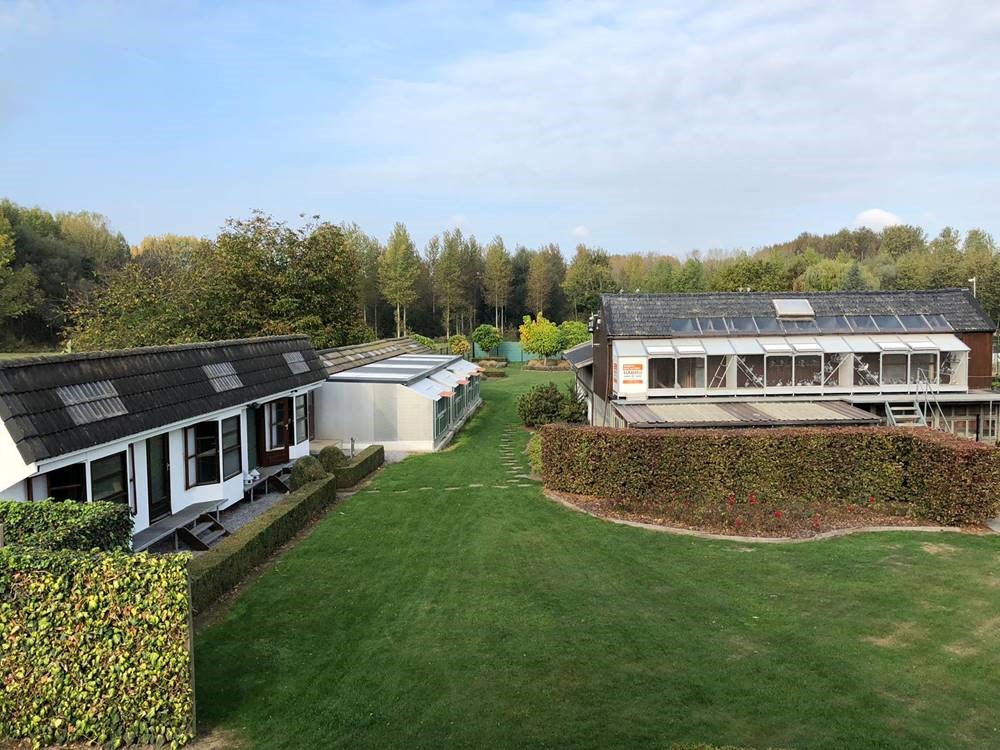
Miscellaneous
Only exceptional racers can go after a 5 year career to the breeding loft. If there isn’t an after breed after one year on the racing loft than the pigeons are being recoupled. Isn’t there an after breed after two years on the racing team than the pigeons are taken out. Compensation breeding is being avoided as much as possible as they try to breed a perfect pigeon. Inbred like for example father x daughter and mother x son is only been done with real top pigeons.
The spine of the Herbots colony is formed by the “Nationaal I” (Schellens) with the “King” (Grondelaers/Soontjens) and “Kenzo” (1st Nat. Ace bird KBDB 2007). For those who see the Herbots team working, the question for their ambition is an unnecessary question. This team is full of ambition and the Olympic thought faster, higher, stronger is written for these guys.
High lights on the breeding loft
*Young Kenzo 5163265-09 , son to KENZO 2116092-04 1st National Ace bird Asduif KBDB small middle distance KBDB 2007 . Young Kenzo himself is a proven racer and father of :
*B13/2172612 was super on the races with a 1st Interprov. Vierzon 2,402b, 1st Interprov. Bourges 1,241b, 1st Argenton 328 b, 2nd Interprov. Bourges 1,517b, 2nd Interprov. Chateauroux 1,056b, 2nd Sourdun 2,482b, 3rd Interprov. Argenton 1,895b, 4th Interprov. Montlucon 1,114b, 8th Interprov. Bourges 2,620b, 9th Interprov. Chateauroux 1,012b, 10th Interprov. Chateauroux 1,550b. Won also 34th Nat. Bourges 9,256b, 47th Nat Chateauroux 5,884b, 56th Nat. Chateauroux 3,933b, 64th Nat. Argenton 13,629b, 83rd Nat. Argenton 1,759b, and so on…
He became father of :
*”Blauwe Parel” B11/2186203 : 4th Olympiad bird Cat. B Nitra 2013, 5th Olympiad bird Cat. D Nitra 2013, 1st Ace bird LCB year birds 2012 and 1st Interprov. Ace bird middle distance year birds Luik-Haspengouw
*”B18/2135035″ : 2nd Argenton 138b, 8th Chateauroux 1,430b, 10th Bourges 1,524b, 45th Chateauroux 1,131b. He became also 1st Interprovincial Ace bird youngsters middle distance 2018 and 3rd Provincial Ace bird KBDB Middle distance 2018 .
*”B14/2313090″ x B11/2186012. The father is an inbred product of “Nationaal I” and the mother is from the old strain of “Number 2″(“Zoon Den 155 Soontjens”) with De Rauw-Sablon. They became parents to B17/2140001, B17/2140002 and B17/2140336 and together they won 2nd National z Argenton 2,855b/4th Nat. Argenton 8,818b, 1st Interprov. Chateauroux 721b, 2nd Argenton 191b, 3rd Vierzon 621b, 4th Momignies 329b, 11th Interprov Tulle 1,527b, 14th Chevrainvilliers 846b, 25th Interprov. Vierzon 4,407b, 43rd Interprov. Vierzon 1,528b, 57th Interprov. Bourges 2,731b.
*”Super Argenton” B11/6329744. He became father of :
– “B18/2135089” with 3rd Interprov. Chateauroux 1,430b
– “B18/2135310” with 5th Interprov. Chateauroux 1,430b
– “B16/2146298” with 6th Interprov. Argenton 2,251b
– “B16/2146765” with 1st Interprov. Bourges 1,517b, 1st Bourges 339b, 1st Chevrainvilliers 101b, 2nd Vierzon 283b, 4th Soissons 340b, 5th Chateauroux 835b, 5th Sourdun 740b, 7th Interprov. Bourges 1,397b, 9th Interprov. Vierzon 2,394b. He became 5th Olympiad bird cat. H 2019, 1st Prov. Ace bird KBDB Greater Middle Distance old birds 2018 and 4th Prov. Ace bird KBDB All Round 2018
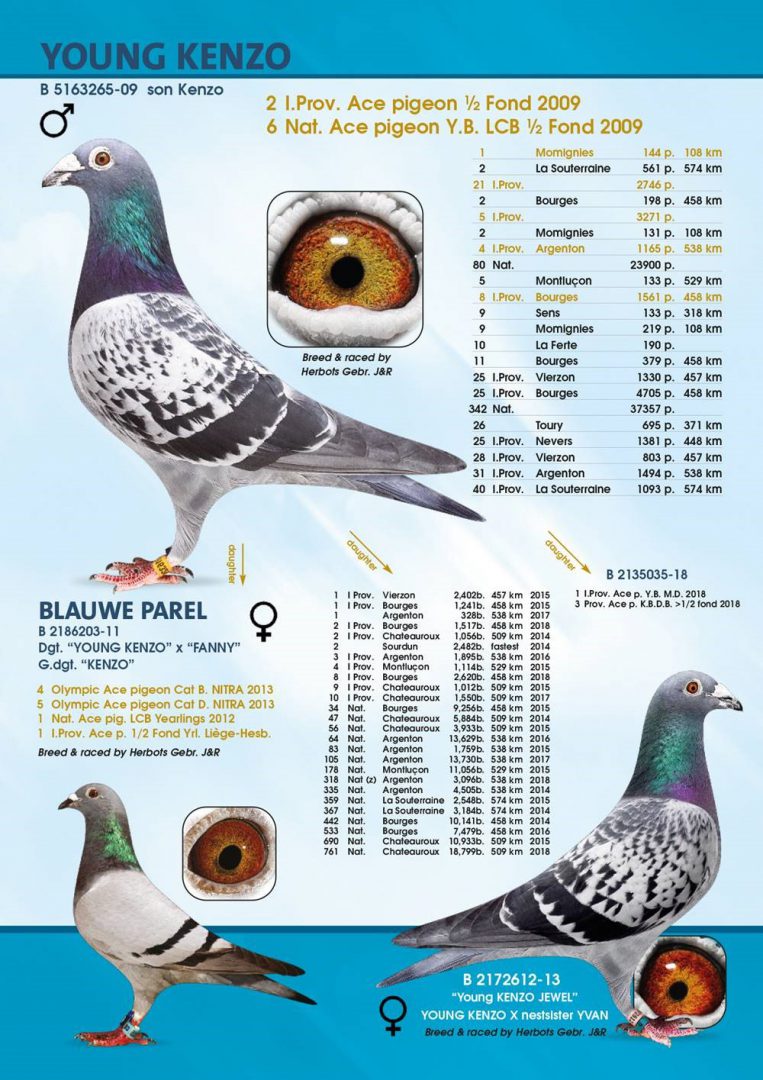
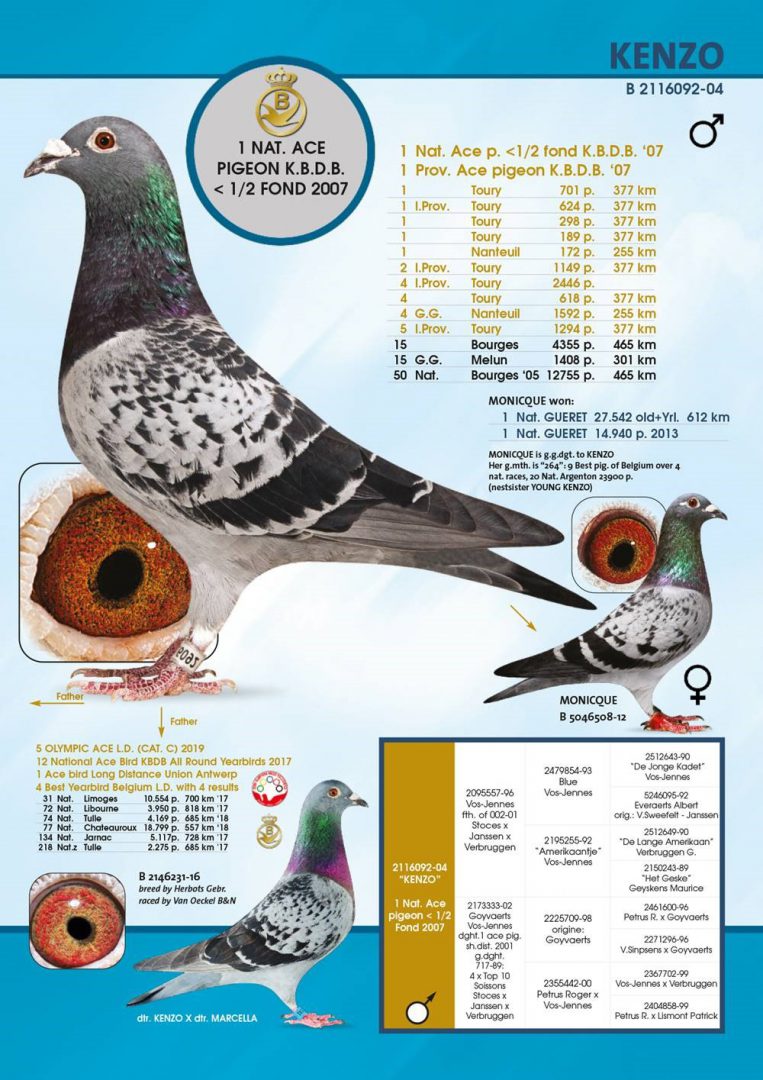
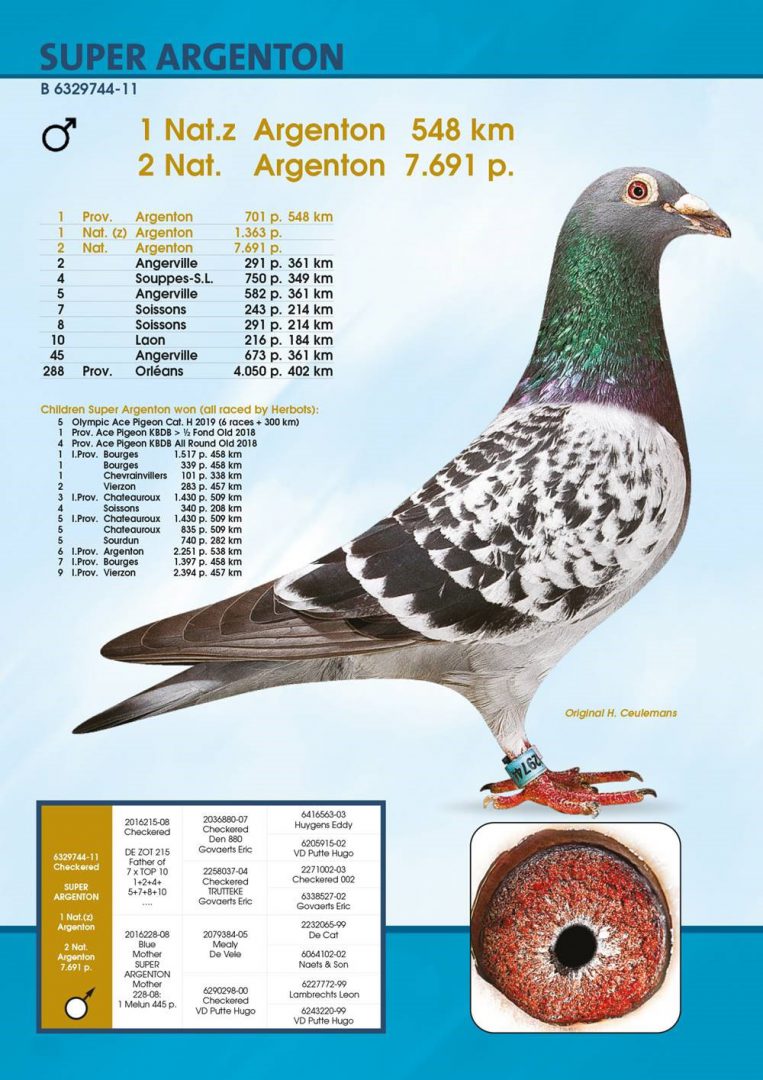
A few top pigeons
* “Yvan” B07/2103401: 1st Interprov. Salbris 2,281b (fastest against 4,774 b), 1st Interprov. Orleans 3,132b, 1st Melun 1,946b, 1st Interprov. Toury 781b (fastest against 3,256b), 1st Argenton 434b, 1st Nanteuil 253b, 1st Pithiviers 172b, 1st Momignies 130b, 7th Interprov. Chateauroux 2,995b, 9th Interprov. Argenton 2,804b, 16th Interprov. Montlucon 1,570b, 20th Interprov. Bourges 1,224b, 21st Interprov. Toury 1,212b, 32nd semi-nat. Chateauroux 9,030b, 43rd Interprov. Chateauroux 1,817b, 52nd Interprov. Orleans 1,058b, 54th Interprov. La Souterraine 1,174b, 57th Nat. Argenton 6,177b. He became 4th National Ace bird Greater Middle Distance 2008 and 1st National Ace bird Small middle distance 2009.
* “Big Boss” DV1274-272-10 : 1 /2,127 b( (615 km), 1/3,496b (329 km), 1/2,080 b (420 km), 1/1,874 b (313 km), 2/3,159 b (429 km), 2/1,237b (313 km), 6/3,587 b(154 km), 7/4,168 b(544 km), 9/5,183 b (429 km), 11/2,219 b (313 km), 13/2,649 b (420 km), 16/3,756 b (429 km), 23/3,262 b (233 km), 31/4,928b (315 km), 37/3,517b (233 km).
He became 1st National Ace bird Germany 2012, 1st Olympiad bird Middle Distance Nitra 2013 and 1st Olympiad bird All Round (11 races) 2013
Children “Big Boss” won : 1st Interprov. Chateauroux 1,511b, 1st semi-nat Vierzon 1,997b, 2nd Interprov. Chateauroux 1,131b, 3rd Interprov. Argenton 1,029b, 4th Interprov. Chateauroux 1,535b, 4th Interprov. Argenton 854b, 5th semi-nat. Bourges I 2,715b, 5th Interprov. Bourges II 1,817b, 7th Interprov. Chateauroux 1,993b, 7th Interprov. Bourges 1,236b, 10th Interprov. Bourges 3,799b, 10th Interprov. Chateauroux 1,460b.
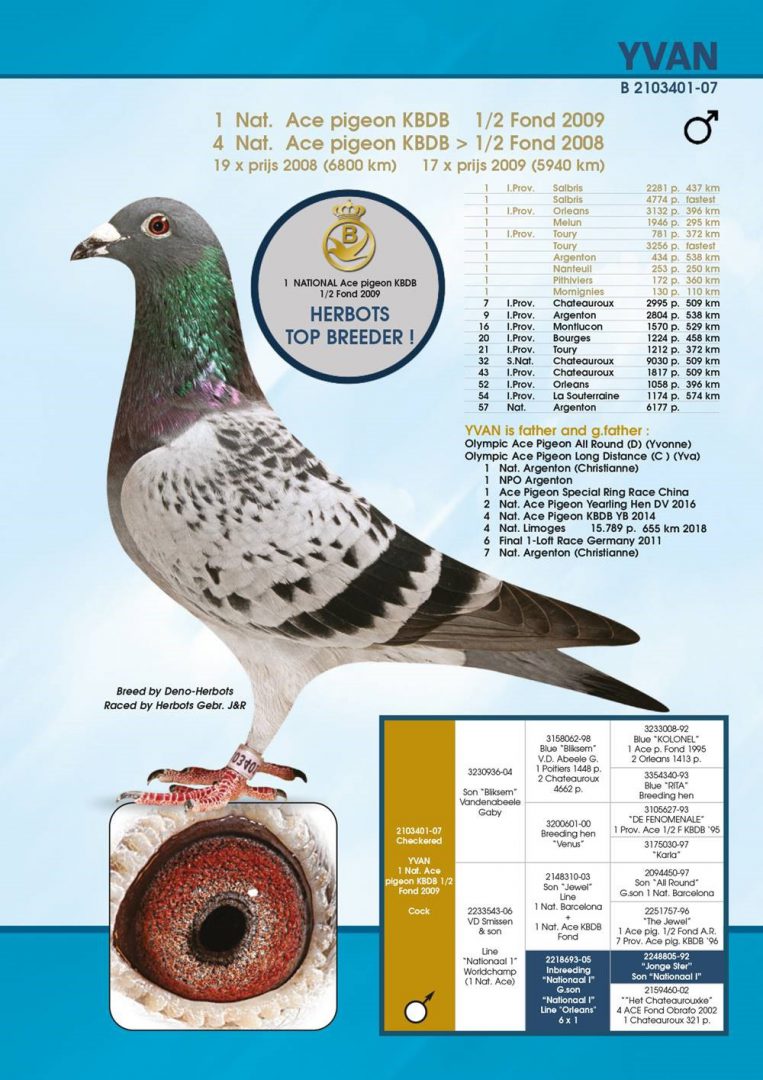
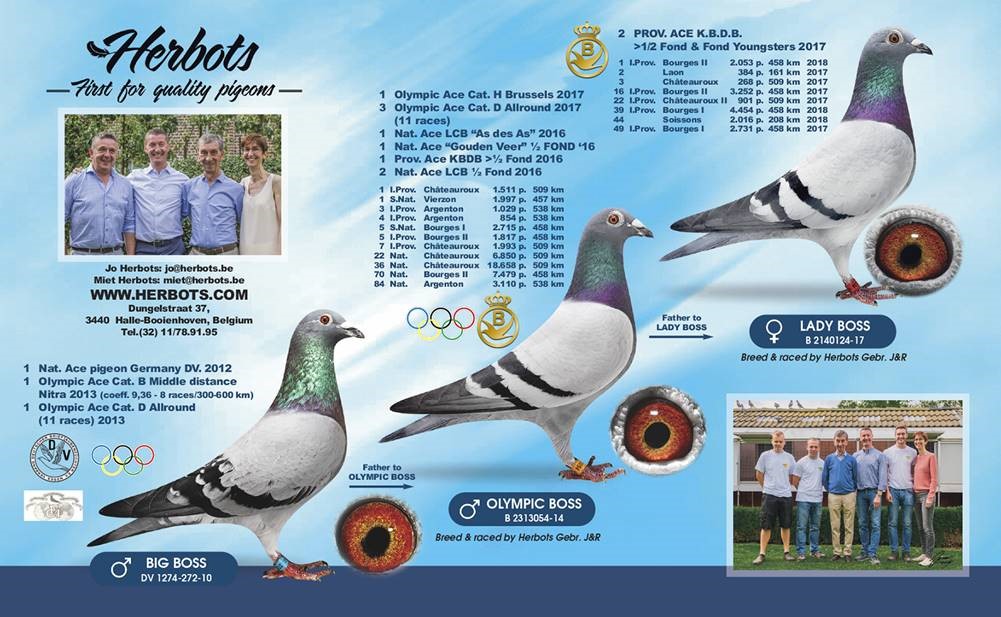

Herbots Gebr. … ready to face the future!
Halle-Booienhoven: maybe it did not occur to you straight away, but when we opened the Herbots Gebroeders’ sensational breeding book, our attention was immediately drawn to the list of Olympic participations of this colony. From the Olympiad in Utrecht (1995) to the last Olympiad in Brussels, the Herbots family delegated no fewer than 12 pigeons (only top-3 spots)! Let’s be clear … these Olympic cracks have all flown in Halle-Booienhoven! Not to mention the Olympiad pigeons they have purchased.
Below, you will find the impressive list of Olympiad participations:
Utrecht 1995 Allround cat. “Olympus” 2053422-93
Bazel 1997 Allround cat. “Boemerang” 1051557-92
Bazel 1997 ½ Long Distance cat. “Den 155” 6371155-91
Blackpool 1999 Allround cat. “Lucky Number” 2087113-97
South-Africa 2001 Allround cat. “Number 1” 5090216-98
Porto 2005 ½ Long Distance cat. “Filip” 2101107-03
Ostend 2007 Allround cat. “Champion B.P.” 2107204-00
Ostende2007 Allround cat. “Olympia” 2267115-05
Nitra 2013 Cat. H. “Els” 2192630-10
Budapest 2015 Cat. B. + C + H. “Yva” 2177058-12
Budapest 2015 Cat. Allround “Yvonne” 2186136-11
Brussels 2017 Cat. Allround “Olympic Boss” 2313054-14
OLYMPIAD PIGEONS…THEY ALL HAVE THEIR OWN STORY
Filip … the first question for you. Where does your love for Olympiad pigeons come from?
This is really easy to explain … a national ace bird is a superb pigeon … delivering top results one year long is pure class … but an Olympiad pigeon has to achieve superior results for 2 seasons and not every pigeon manages to do this two seasons in a row.
In my modest opinion, the Olympiad pigeons are the national ace birds that have been selected even more rigorously. The real super pigeons amongst the super pigeons … Some luck is involved, though, as the results have to be achieved in the right years. Take our current base breeder ‘Yvan’ for example … he became 4th national ace bird KBDB Long Middle Distance 2008 and 1st national ace bird KBDB Middle Distance 2009 … However, these seasons were not taken into account for the Olympiad results, so ‘Yvan’ never became an Olympic bird!
Having coached so many Olympiad pigeons during their entire racing career as a fancier, you must have discovered some typical features to recognize a future Olympiad pigeon?
Yes … let me think … a common feature … this may be disappointing but I can only answer that each and every Olympic bird has its own story and that they never look ugly in the hand. As pigeon brokers, we have held many Olympiad pigeons in our hands and found them in different shapes and sizes. If there was a mutual feature, pigeon sport would immediately be a thing of the past as only the well-off fanciers could afford these top pigeons.
You say each Olympiad pigeon has its own story … what do you mean exactly?
Well … take our Brussels Olympic bird in the all-round category ‘Olympic Boss’ (B14-2313054) for example. As a young bird, he performed well, but not remarkably. He was particularly talked about when he stayed behind in the very bad Gueret in 2014. The pigeons were only released at 10.30 AM and with severe head wind and dark weather to make things worse. None of the clubs was able to close the race the same day … that says enough! “Olympic Boss” was called in a few days later only at 3 km from his own loft. He was caught by a pig farmer … completely exhausted and skinny as hell. Nevertheless we gave him another chance and he recovered extremely fast, which is always a good sign. ‘Olympic Boss’ pulled through the moulting period perfectly and got his second chance as a yearling. He did not disappoint and two years later we can add the Olympic nomination to his impressive list of victories.
As in top achievements, the ‘Olympic Boss’ was always extremely motivated when he was basketed before a race. You know we use the chaos system of total widowhood. Well, the ‘Olympic Boss’ had two hens … one in his box and a second one he could cuddle with in an overturned cardboard box in the corridor. He did not know where to go first … and when he was with his hen in his box and he saw another cock sitting on his cardboard box in the corridor, he felt compelled to chase it away immediately of course. A super motivation with a super performance as a result. We did however also make the mistake of always basketing both hens for the race and when one of the hens stayed behind from a race, this seriously harmed his motivation. Luckily he had already pocketed the necessary results for his Olympic nomination.
BREEDING WITH LESBIAN HENS
So there you are … with an Olympic crack in a breeding box … how do you manage to breed good pigeons out of him?
We have to be honest and confess that for us too, it is a matter of playing with mother nature’s heredity laws … breeding a lot and selecting very rigorously is still the shortest route to success. However, we are 100% convinced that you have more luck breeding good pigeons when you start with super pigeons at the base …’you can never breed a racing horse out of a donkey’ says the farmer … and he is right. That is why the selection of hens – against which the Olympic winner is coupled – is very important. We cannot rush this … no … a fancier needs to take his time to decide. The hens are selected from a strain we believe in. Take the breeding line of our ‘Yvan’ for example (traces back to Vandenabeele’s ‘Bliksem’ Vandenabeele) – the strain of ‘Nationaal I’ (Schellens) and the old base of our 2nd Olympic bird “155” (Grondelaers x Soontjens). The last few years the Heremans-Ceusters pigeons are becoming more and more important in our breeding loft as well. So, when selecting the hens we make sure that their pedigree is spiced with one of these breeding lines.
So the Olympic cock has the mark of ‘bull’ tattooed onto his chest for the rest of his life?
No … that is not exactly true … look … we always have two cocks ready to follow the ‘bull-method’ with. This can be ‘Big Boss’ and ‘Yvan’ and can change to ‘Olympic Boss’ and ‘New Belgian Pride’ a few weeks later. When the cocks are not being used as a bull, they just stay in their breeding boxes with a hen, follow the normal cycle and bring up a pair of youngsters.
What do we need for a successful ‘bull method’? First of all two superior (breeding) cocks … secondly 24 lesbian hens (the ideal is to choose 2-year old and 3-year old hens) from the abovementioned breeding lines and thirdly many feeding couples.
The hens are well prepared before being coupled and as we work with 2-year old and 3-year old hens, they pair up rather easily. Once they are well paired, they are handled daily and when they start opening up, they can go to one of the ‘bulls’ one by one so he can do his job. All 24 hens are being put with the cocks every day. Once the hens have laid their eggs, one couple of eggs stays with them and the other pair will go to a feeding couple. This way we can have many youngsters from a few cocks with different hens in a short time. To be entirely sure, we have a DNA analyses performed for every youngster.
BREEDING FROM OLYMPIC BIRDS … NO GUARANTEE BUT GREATER CHANCE FOR SUCCESS
Breeding from Olympiad pigeons… I can imagine that it is not all gold that glitters?
Let’s be honest … not every youngster of an Olympiad can be superb, but we are all convinced that the chances for success are much bigger. We have actually bred top pigeons from all our Olympiad pigeons. If not with the first generation, we definitely had successes with the 2nd and 3rd generations. A few examples to support our statement:
‘Den 155’ (B91-6371155 – Olympiad pigeon Bazel ’97) became father of a.o. “Number 1” (B98-5090216 – Olympiad pigeon South-Africa 2001 and 1st National ace bird KBDB Middle Distance 1999)
‘Number 1’ (B98-5090216 – Olympiad pigeon South-Africa 2001) became grandfather of “Champion B.P.’ (B04-2107204 – Olympiad pigeon Ostend 2007). “Number 1” is also grandfather of a.o. ‘Royal Prins’ (B10-2192064 – won 4 x Top-100 National)
‘Multi 155’ (B08-2169207 – 4th Olympiad pigeon 2011) is a double great-grandson of ‘Den 155’ and a great-grandson “Number 1”.
‘Filip’ (B03-2101107 – Olympiad pigeon Porto) became father of several 1st prize racers but also at the German champion Karsten-Ploog a daughter “Filip” raced amazingly well with 1st against 7,456b. – 1st against 2,318b. – 1st against 914b., this all without doubles.
‘Lucky Number’ (B97-2087113 – Olympiad pigeon Blackpool) became father of a.o. 4th provincial ace bird KBDB .
‘Els’ (B10-2192630 – Olympiad pigeon Nitra) is also mother of 1st prize winners
‘Big Boss’ (DV01274-10-272 – Olympiad pigeon Nitra) is father of ‘Olympic Boss’ (B14-2313054 – Olympiad pigeon Brussels) …
I know that ‘Yvan’ (B07-2103401) does not have an Olympiad nomination … but if he had flown his results in the ‘right years’, he would have had an excellent chance of becoming an Olympiad pigeon… Well, ‘Yvan’ has already produced many superb pigeons both in our own loft and in many other lofts. He is father of ‘Yvonne’ (B11-2186136)… Olympiad pigeon All-round Budapest 2015 amongst others, but also father of the other Olympiad pigeon ‘Yva’ (B12-2177058 – Olympiad pigeon Cat. C Long Distance Budapest 2015). In the meantime, ‘Yvan’ is also grandfather of ‘Christianne’ (B13-2172001 – 1st National Argenton and 7th National Chateauroux) and at our sports friend Faber, ‘Yvan’ is grandfather of the 2nd National ace bird yearling hens of Germany. Anton Ruitenberg (NL) has also bred top pigeons out of a child of ‘Yvan’ with amongst others 1st NPO Argenton and 10th NPO Chateauroux . Oh yes … the 4th national ace bird KBDB youngsters 2014 at Luc Van Mechelen has “Yvan” as its grandfather and the great-grandfather of the 1st Olympiad pigeon Brussels for Czech Republic is also “Yvan”… and so on and so forth.
This cannot all be coincidence, can it? And who knows what the future will bring?
Jo … what convinced you to buy the Olympiad pigeon ‘Big Boss’, father of ‘Olympic Boss’?
I saw ‘Big Boss’ for the first time when he was showing off in an exposition cage at the Olympiad in Nitra. His sublime results drew my attention … 1st National ace bird Germany 2012 – 1st Olympiad pigeon middle distance with a coefficient of 9,36% over 8 races between 300km and 600km and 1st Olympiad pigeon all-round (over 11 races). Even without holding him in my hand and without seeing any pedigree, I took my chance and transferred this crack from Wolfgang Roeper to Halle-Booienhoven. When I saw his pedigree, I saw that he had a lot of short-distance blood running through his veins. His father is the ‘Blauwe Wouters’ (B08-6293402 – a full brother of ‘Blue Dream’, 1st national ace bird KBDB short distance) and his mother is DV7107-336-09 (a daughter of ‘De Gus’ – B03-6032858 – which is a full brother of Heremans-Ceusters’ famous ‘Olympiade 003’).
‘Big Boss’ is a cock of the smaller type, well feathered and with a unique character head on a strong carcass. Coupled to “B13-2188001” (a granddaughter of “Olympiade 003”) he produced “Olympic Boss”. “Olympic Boss” is a bit larger than his father and has a wider carcass under his impressive wings. I assume that nothing can go wrong with this kind of pigeons.
Family Herbots from Halle-Booienhoven … we are convinced that we have not seen their last top result yet … the entire Herbots team is much too motivated! We are looking forward to our next meeting … good luck!

